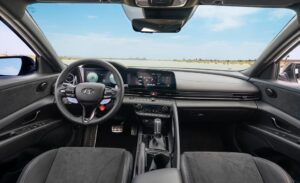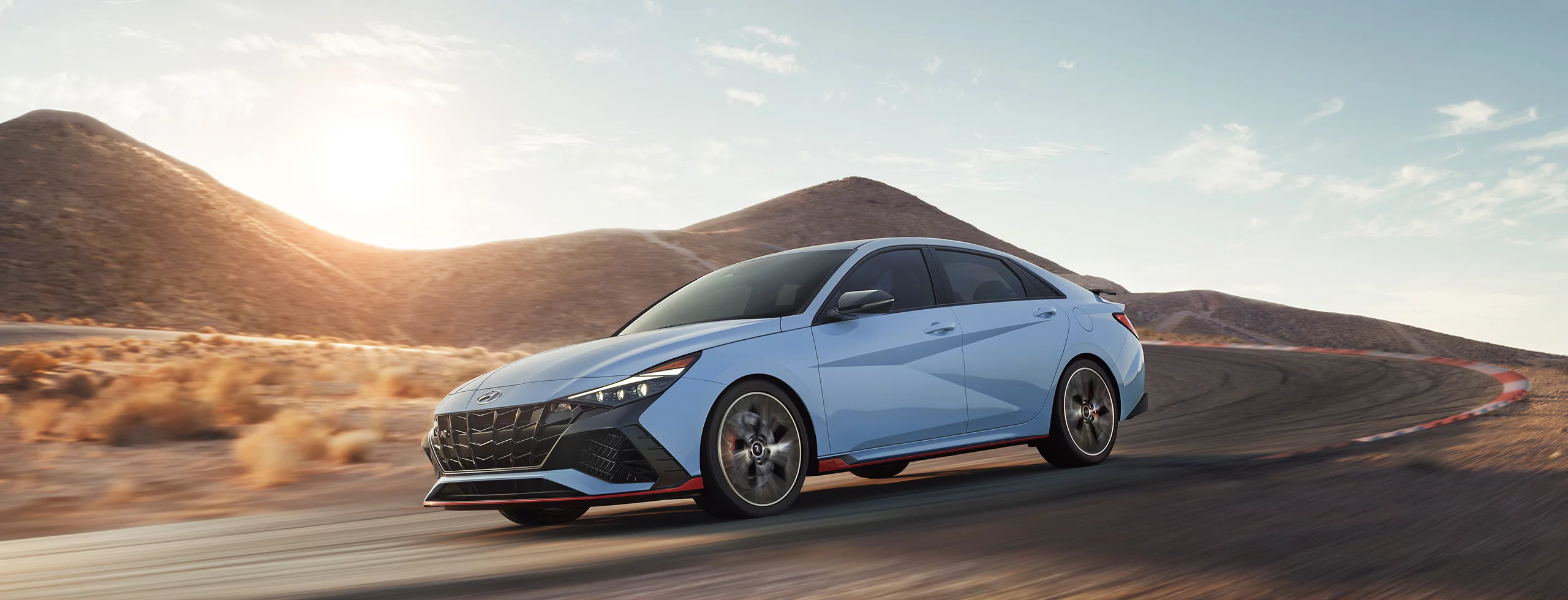As much as we love manual transmissions, we also enjoy making fun-to-drive vehicles as accessible to as many people as possible. We’ve already driven—and adored—the Hyundai Elantra N with a six-speed manual, and you’ll be pleased to know that replacing the stick with an eight-speed dual-clutch automatic does nothing to mess with the car’s metric truckload of daily-driven-sports-sedan excellence.
Manuals are always at a disadvantage against faster cog-swappers when it comes to acceleration. At 4.8 seconds to 60 mph, the dual-clutch Elantra N bested its stick sibling by 0.3 second—Hyundai’s swinging for the fences, too, because it’s also one-tenth quicker to 60 than the new Honda Civic Type R. It also held its own against the Honda in the quarter-mile hustle, besting the Type R by one-tenth (13.4 seconds vs. 13.5) and tying its 106-mph trap speed. Not bad for a turbocharged 2.0-liter inline-four making 286 horsepower and 289 pound-feet of torque.


Fuel economy also benefits when the gears don’t stop at six. At 37 mpg on our 75-mph highway loop, the automatic-equipped Elantra N trounced the manual Elantra’s 32-mpg result. Then again, the Elantra is thrifty no matter what; the six-speed variant beat out other manual-equipped performers such as the Civic Type R (30 mpg) and the Subaru WRX (28 mpg), although the Subie is handicapped by its standard all-wheel drive. The only competitor the automatic can’t top is the cheaper, less powerful Honda Civic Si, which managed 38 mpg in our hands.
The Elantra N’s dual-clutch confers a weight penalty of 114 pounds, with our automatic test car weighing 3313 pounds on our scales versus the manual’s 3199. That had a very mild effect on its braking figures, with the automatic stopping from 70 mph in 161 feet and from 100 mph in 324 feet—a bit longer than the manual’s 156-foot and 318-foot stops, respectively. The dual-clutch model’s stopping power is similarly off from the Subaru WRX.
At 0.96 g on our skidpad, the Elantra N exhibits plenty of stick, but the sports-sedan joie de vivre extends beyond numbers on a page. Lateral body motions are kept well in check, especially in stiffer suspension settings, and the steering provides some decent feedback, even if its various weights feel wholly artificial. Don’t overdrive the thing and the electronic limited-slip differential will efficiently mete out power to either front wheel; rely a little too much on the Michelin Pilot Sport 4S summer tires, though, and it’s a one-way trip to Understeer City. The dual-clutch does a great job hustling between gears once underway, although it can operate with some clunks and shudders at rush-hour speeds.


Customisation also helps make the Elantra N so interesting; on the dual-clutch Elantra, a driver can swap between two to three different settings each for the engine, steering, suspension, transmission, limited-slip differential, stability control, and exhaust note—a whopping 1458 possible permutations. Helpfully, you can assign your personal favourites to one of the N buttons on the steering wheel for quick access.


These modes aren’t just for show, either; there are demonstrable differences in each setting. Throttle response varies from daily-driver soft to a binary input. You can ratchet the steering’s weight so high that it counts as a gym membership. The suspension soaks up a good bit of movement in Normal mode, but it’ll rattle your fillings out in Sport+. With the exhaust set to Sport+, even a light lift of the right pedal will generate several seconds of overrun so powerful it could be sold at Phantom Fireworks. But if you keep it all in Normal, the N feels pretty darn close to any other Elantra out there.
Heck, aside from a few N-specific touches, the Elantra’s interior isn’t far off from its pedestrian variant. There’s a dash of blue contrast stitching and some cool illuminated badges in the seats, but otherwise, it’s My Chemical Romance’s “Welcome to the Black Parade” in the cabin, which like the song is a little dull once you grow out of your emo phase. The lack of USB-C ports in 2023 is a bit of a bummer, as well, but at least there’s a wireless charger if you fancy not one, but two slow ways to charge a phone. A pair of 10.3-inch displays cover instrumentation and infotainment duty, and both are easy to master.
The pendulum swings wildly between the Elantra N’s cabin and its exterior. With an already-large grille and additional blacked-out elements on either side, this sprightly sedan looks more like a pissed-off remora than a family car. A little bit of red trim around the bottom of the body shouts “Sporty!” just in case the rear wing and honkin’ dual tailpipes don’t give it away. But credit where it’s due, Hyundai’s wild styling stands out from the competition; Subaru has apparently given up evolving the WRX, we’re pretty sure German law dictates that every new GTI looks derivative, and the 11th-gen Civic has gone conservative after the 10th gen’s seemingly mescaline-induced reverie.
At $35,515, the DCT Elantra N comes loaded with everything mentioned above—and then some. The Honda Civic Si is closer to $30,000, but it lacks theatrics or any sort of customizability. The GTI SE, our preferred trim, is more expensive and has less power, but it does have plaid cloth. The Subaru WRX is evenly priced, but it’s thirsty and it looks the way it does. Thus, the Elantra N represents a pretty screaming deal considering the average price of a new car these days. Moreover, the Elantra N is genuinely fun to drive across a variety of scenarios—even with a gearbox that shifts for itself.
source: caranddriver










